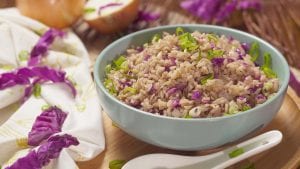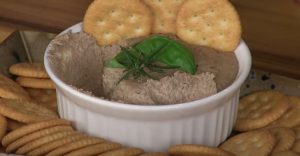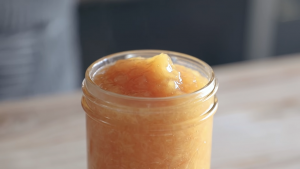This Indian cabbage stir-fry recipe is a delightful, quick, and nutritious dish that combines the crunchiness of cabbage with flavorful spices. Perfect for a light lunch or a side dish, this recipe will introduce you to the vibrant tastes of Indian cuisine.
Some ingredients in this recipe may not be commonly found in your pantry, such as black mustard seeds, fresh curry leaves, asafoetida powder, and fresh coconut. If you don't have these at home, you might need to visit a specialty store or an international market to find them.
Ingredients For Indian Cabbage Stir-Fry
split mung beans: These legumes add protein and a slightly nutty flavor to the dish.
water: Used for soaking and boiling the mung beans.
cabbage: The main vegetable, providing a crunchy texture.
salt: Enhances the flavors of the dish.
extra-virgin olive oil: Used for stir-frying and adds richness to the flavor profile.
black mustard seeds: Impart a pungent, nutty flavor when heated.
fresh curry leaves: Add a distinct aromatic flavor to the dish.
garlic cloves: Provide a savory and aromatic base.
cumin seeds: Give a warm, earthy flavor.
asafoetida powder: A spice with a strong aroma that adds a unique depth of flavor.
turmeric: Adds a warm, bitter flavor and a beautiful golden color.
red chile powder: Provides a hint of heat to the dish.
fresh coconut: Adds a sweet, nutty flavor and texture.
cilantro leaves: Used for garnish, adding freshness and a pop of color.
One reader, Adena Ruth says:





This Indian cabbage stir-fry recipe is a delightful blend of flavors and textures. The spices are perfectly balanced, and the fresh coconut adds a wonderful touch. It's easy to make and a great way to enjoy cabbage. Highly recommend!
Techniques Required for Indian Cabbage Stir-Fry
How to soak mung beans: Place mung beans in a large container and cover with several inches of cool water; let soak for 4 hours. How to cook mung beans: Bring water to a boil in a large pot. Add the drained mung beans and cook until almost tender for 10 to 15 minutes. How to test oil temperature: Heat olive oil in a large skillet over high heat. Test the heat by adding 1 mustard seed. Oil is hot enough if the seed splutters. How to stir-fry cabbage: Squeeze out excess moisture from the cabbage. Add in small amounts to the skillet, stirring well between additions. Stir-fry cabbage mixture for 2 to 3 minutes.
How To Make Indian Cabbage Stir-Fry
This Indian cabbage stir-fry is best served with rotis, naan, or rice. Mung beans and shredded cabbage tossed with Indian spices and cooked in a skillet.
Serves:
Ingredients
- ½cupsplit mung beans
- 8cupswater
- 1head cabbage,shredded, small
- salt,to taste
- 3tbspextra-virgin olive oil
- ½tspblack mustard seeds
- 6fresh curry leaves,or more to taste
- 2garlic cloves,crushed
- ⅛tspcumin seeds
- ⅛tspasafoetida powder
- ¼tspturmeric,ground
- pinchred chile powder,or to taste
- 3tbspfresh coconut,grated
- 1tbspcilantro leaves,minced
Instructions
-
Place mung beans in a large container and cover with several inches of cool water; let soak for 4 hours. Drain.
-
Bring water to a boil in a large pot. Add the drained mung beans. Cook until almost tender for 10 to 15 minutes.
-
Remove from heat. Stir cabbage and salt into the pot. Let stand until cabbage wilts for about 10 minutes.
-
Drain the cabbage mixture in a colander and set aside.
-
Heat olive oil in a large skillet over high heat. Test the heat by adding 1 mustard seed. Oil is hot enough if the seed splutters.
-
Add remaining mustard seeds, curry leaves, garlic, cumin seeds, and asafoetida. Cook for 1 minute.
-
Squeeze out excess moisture from the cabbage. Add in small amounts to the skillet, stirring well between additions. Stir-fry cabbage mixture for 2 to 3 minutes.
-
Season with salt, turmeric, and chile powder. Reduce heat to low and stir-fry for 4 to 5 minutes more. Garnish with coconut and cilantro.
Nutrition
- Calories: 259.41kcal
- Fat: 12.11g
- Saturated Fat: 2.71g
- Trans Fat: 0.00g
- Monounsaturated Fat: 7.61g
- Polyunsaturated Fat: 1.27g
- Carbohydrates: 32.01g
- Fiber: 10.88g
- Sugar: 9.61g
- Protein: 9.61g
- Sodium: 1756.05mg
- Calcium: 157.90mg
- Potassium: 760.39mg
- Iron: 3.65mg
- Vitamin A: 17.19µg
- Vitamin C: 89.54mg
Technique Tip for Perfecting Indian Cabbage Stir-Fry
To enhance the flavor of the curry leaves, lightly crush them between your fingers before adding them to the hot oil. This releases their essential oils, making the dish more aromatic and flavorful.
Time-Saving Tips for Indian Cabbage Stir-Fry Recipe
Soak mung beans overnight: Save time by soaking split mung beans overnight instead of 4 hours.
Pre-shred cabbage: Use pre-shredded cabbage from the store to cut down on prep time.
Use a food processor: Minimize chopping time by using a food processor for garlic and cilantro.
Cook beans in advance: Cook and store mung beans in the fridge a day ahead.
Batch cook: Double the recipe and freeze half for a quick meal later.
Pre-measure spices: Measure out all spices in advance to streamline the cooking process.
Substitute Ingredients For Indian Cabbage Stir-Fry Recipe
split mung beans - Substitute with yellow split peas: Yellow split peas have a similar texture and cooking time, making them a good alternative.
water - Substitute with vegetable broth: Vegetable broth adds more flavor to the dish compared to plain water.
cabbage - Substitute with kale: Kale has a similar texture and can hold up well in a stir-fry.
salt - Substitute with soy sauce: Soy sauce can add a salty and umami flavor to the dish.
extra-virgin olive oil - Substitute with coconut oil: Coconut oil complements the Indian flavors and has a higher smoke point.
black mustard seeds - Substitute with yellow mustard seeds: Yellow mustard seeds have a similar flavor profile and can be used interchangeably.
fresh curry leaves - Substitute with bay leaves: Bay leaves can provide a similar aromatic quality, though the flavor will be slightly different.
garlic cloves - Substitute with garlic powder: Garlic powder can be used if fresh garlic is not available, though the flavor will be less intense.
cumin seeds - Substitute with ground cumin: Ground cumin can provide the same flavor, but use a smaller quantity as it is more concentrated.
asafoetida powder - Substitute with onion powder: Onion powder can mimic the savory depth that asafoetida provides.
turmeric - Substitute with saffron: Saffron can add a similar color and a unique flavor, though it is more expensive.
red chile powder - Substitute with paprika: Paprika can add a similar color and a mild heat to the dish.
fresh coconut - Substitute with dried coconut flakes: Dried coconut flakes can provide a similar texture and flavor when fresh coconut is not available.
cilantro leaves - Substitute with parsley: Parsley can add a fresh, herbaceous note similar to cilantro.
Presenting Indian Cabbage Stir-Fry in Style
Use a pristine white plate: The clean, white background will make the vibrant colors of the cabbage and curry leaves pop, creating a visually appealing contrast.
Create a base layer: Spread a thin, even layer of the stir-fried cabbage mixture on the plate. This will act as the foundation for the dish and ensure that every bite has a bit of everything.
Add height with mung beans: Place a small mound of the cooked mung beans in the center of the cabbage layer. This adds height and dimension to the presentation.
Garnish with fresh coconut: Sprinkle fresh coconut shavings over the top of the dish. The white coconut will add a touch of elegance and a hint of sweetness.
Finish with cilantro leaves: Artfully place a few cilantro leaves on top of the dish. This adds a burst of green color and a fresh aroma.
Drizzle with olive oil: Lightly drizzle some extra-virgin olive oil around the plate for a glossy finish and added richness.
Use microgreens for a touch of sophistication: Add a small bunch of microgreens on the side of the plate. This not only enhances the visual appeal but also adds a layer of texture.
Serve with a side of lemon wedge: Place a lemon wedge on the side of the plate. This provides an option for diners to add a splash of acidity to balance the flavors.
Ensure symmetry and balance: Arrange the elements symmetrically to create a balanced and harmonious presentation. This attention to detail is crucial for a Michelin-star-worthy dish.
Essential Tools for Making Indian Cabbage Stir-Fry
Large container: Used for soaking the split mung beans in water for 4 hours.
Large pot: Essential for boiling water and cooking the mung beans until they are almost tender.
Colander: Necessary for draining the cabbage and mung bean mixture after cooking.
Large skillet: Used for heating the olive oil and stir-frying the cabbage mixture with spices.
Measuring cups: Important for accurately measuring the split mung beans and water.
Measuring spoons: Needed for measuring out the spices and olive oil.
Knife: Required for chopping the cabbage and garlic cloves.
Cutting board: Provides a safe surface for chopping the cabbage and garlic.
Wooden spoon: Useful for stirring the cabbage mixture in the skillet.
Spatula: Helps in mixing and turning the cabbage mixture while stir-frying.
Serving bowl: Ideal for serving the finished Indian cabbage stir-fry.
Storing and Freezing Indian Cabbage Stir-Fry
- To store leftover indian cabbage stir-fry, allow it to cool completely to room temperature before transferring it to an airtight container. Refrigerate for up to 3-4 days.
- When ready to reheat, place the desired amount of stir-fry in a skillet over medium heat. Add a splash of water or vegetable broth to help rehydrate the dish and prevent it from sticking to the pan. Stir occasionally until heated through.
- For longer storage, you can freeze the cabbage stir-fry. Place the cooled stir-fry in a freezer-safe container or resealable bag, removing as much air as possible to prevent freezer burn. Label the container with the date and freeze for up to 2-3 months.
- To reheat frozen stir-fry, thaw it overnight in the refrigerator. Once thawed, reheat it in a skillet over medium heat, adding a small amount of water or vegetable broth to help reconstitute the dish. Stir occasionally until heated through and the liquid has evaporated.
- Tip: If you plan on freezing the stir-fry, you may want to slightly undercook the cabbage to maintain a better texture when reheated. The cabbage will continue to soften during the freezing and reheating process.
How To Reheat Leftover Indian Cabbage Stir-Fry
Reheat the leftover indian cabbage stir-fry in a skillet or wok over medium-high heat. Add a small amount of olive oil or ghee to the pan to prevent sticking and to enhance the flavors. Stir-fry the cabbage mixture for 3-4 minutes, or until heated through and slightly crispy.
For a quick and easy reheating method, microwave the leftover cabbage stir-fry in a microwave-safe dish. Cover the dish with a damp paper towel to prevent the cabbage from drying out. Microwave on high for 1-2 minutes, stirring halfway through, or until the cabbage is heated through and steaming.
If you prefer a softer texture, reheat the leftover cabbage stir-fry in a covered saucepan over low heat. Add a splash of water or vegetable broth to the pan to create steam and prevent the cabbage from sticking. Simmer the cabbage mixture for 5-7 minutes, stirring occasionally, or until heated through and tender.
For a crispy and flavorful twist, spread the leftover indian cabbage stir-fry on a baking sheet lined with parchment paper. Drizzle with a small amount of olive oil and sprinkle with additional spices, such as cumin, coriander, or garam masala. Broil the cabbage mixture in the oven for 2-3 minutes, or until crispy and lightly charred around the edges.
To infuse the leftover cabbage stir-fry with fresh flavors, reheat it in a skillet or wok over medium-high heat and add a handful of chopped fresh herbs, such as cilantro, mint, or curry leaves. Stir-fry the cabbage mixture with the herbs for 2-3 minutes, or until heated through and fragrant.
Interesting Fact About Indian Cabbage Stir-Fry
A unique aspect of this Indian cabbage stir-fry recipe is the use of asafoetida powder, a pungent spice commonly used in Indian cuisine. It adds a distinct flavor and is known for its digestive benefits.
Is Indian Cabbage Stir-Fry Recipe Budget-Friendly for Home Cooking?
This Indian cabbage stir-fry recipe is quite cost-effective for a household. The main ingredients like cabbage, mung beans, and spices are affordable and easily available. The use of extra-virgin olive oil and fresh coconut might slightly increase the cost, but overall, it remains budget-friendly. The approximate cost for a household of 4 people is around $10-$12. Overall Verdict: 8/10.
Is This Indian Cabbage Dish Healthy or Unhealthy?
This Indian cabbage stir-fry recipe is a nutritious and wholesome dish. The use of mung beans provides a good source of plant-based protein, fiber, and various vitamins and minerals. Cabbage is low in calories and rich in vitamins C and K, as well as antioxidants. The addition of spices like turmeric and cumin not only enhances the flavor but also offers potential health benefits due to their anti-inflammatory properties. The recipe uses a moderate amount of healthy fat in the form of extra-virgin olive oil, which is known for its heart-healthy monounsaturated fats.
To further enhance the nutritional value of this dish, consider the following suggestions:
- Increase the variety of vegetables by adding carrots, bell peppers, or green beans to boost the fiber content and provide a wider range of vitamins and minerals
- Replace the extra-virgin olive oil with coconut oil, which is more suitable for high-heat cooking and offers unique health benefits such as lauric acid
- Incorporate additional protein sources like tofu or tempeh to make the dish more satiating and balanced
- Reduce the amount of salt used and instead rely on the natural flavors of the spices and vegetables to keep sodium levels in check
- Serve the stir-fry with a side of brown rice or quinoa to add complex carbohydrates and additional fiber to the meal
Editor's Opinion on This Indian Cabbage Stir-Fry Recipe
This Indian cabbage stir-fry recipe is a delightful blend of textures and flavors. The split mung beans add a subtle nuttiness, while the cabbage provides a crisp contrast. The use of black mustard seeds, curry leaves, and asafoetida introduces authentic Indian aromas, making the dish aromatic and inviting. The fresh coconut and cilantro garnish add a refreshing finish. However, using extra-virgin olive oil is unconventional in Indian cooking; substituting it with ghee or a neutral oil could enhance authenticity. Overall, it's a vibrant, nutritious dish that balances simplicity with rich, complex flavors.
Enhance Your Indian Cabbage Stir-Fry Recipe with These Unique Side Dishes:
Similar Recipes to Indian Cabbage Stir-Fry
Appetizers and Desserts That Complement Indian Cabbage Stir-Fry
Why trust this Indian Cabbage Stir-Fry Recipe:
This recipe combines traditional Indian spices with the nutritious benefits of cabbage and mung beans. The use of fresh curry leaves and coconut adds authentic flavors, while the step-by-step instructions ensure a foolproof cooking process. The inclusion of asafoetida and turmeric not only enhances taste but also offers health benefits. Trust this recipe for a delicious and wholesome stir-fry that brings the essence of Indian cuisine to your kitchen.
Was this page helpful?
Have your own special recipe to share? Submit Your Recipe Today!












